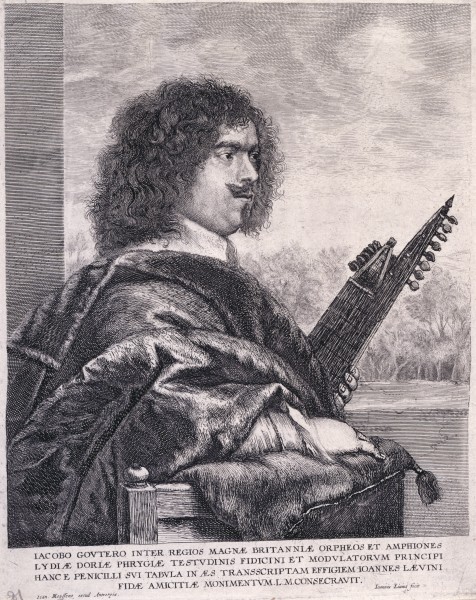Jacques Gaultier on:
[Wikipedia]
[Google]
[Amazon]
 Jacques Gaultier (or Gauterius, Gouterus, Goutier, Gautier, Gautier d'Angleterre, also James Gwaltier) (born ca. 1600, fl. 1617 – 1652) was a French Baroque
Jacques Gaultier (or Gauterius, Gouterus, Goutier, Gautier, Gautier d'Angleterre, also James Gwaltier) (born ca. 1600, fl. 1617 – 1652) was a French Baroque
German
Wikipedia
Portrait by Jan LievensPortrait by Jan Lievens
* {{DEFAULTSORT:Gaultier, Jacques 1600s births 17th-century deaths French lutenists French male classical composers French Baroque composers 17th-century classical composers 17th-century male musicians
 Jacques Gaultier (or Gauterius, Gouterus, Goutier, Gautier, Gautier d'Angleterre, also James Gwaltier) (born ca. 1600, fl. 1617 – 1652) was a French Baroque
Jacques Gaultier (or Gauterius, Gouterus, Goutier, Gautier, Gautier d'Angleterre, also James Gwaltier) (born ca. 1600, fl. 1617 – 1652) was a French Baroque lute
A lute ( or ) is any plucked string instrument with a neck and a deep round back enclosing a hollow cavity, usually with a sound hole or opening in the body. It may be either fretted or unfretted.
More specifically, the term "lute" can ref ...
nist and composer. He was not related to the composers and lutenists Denis Gaultier
Denis Gaultier (''Gautier'', ''Gaulthier''; also known as Gaultier le jeune and Gaultier de Paris) (1597 or 1602/3 – 1672) was a French lutenist and composer. He was a cousin of Ennemond Gaultier.
Life
Gaultier was born in Paris; two conflict ...
and Ennemond Gaultier.
Not much is known about his early life. In 1617, he had to leave France due to a duel
A duel is an arranged engagement in combat between two people, with matched weapons, in accordance with agreed-upon Code duello, rules.
During the 17th and 18th centuries (and earlier), duels were mostly single combats fought with swords (the r ...
and he escaped to England. He enjoyed the patronage of George Villiers, the favourite of James I of England. In 1622, Gaultier met Dutch poet and composer Constantijn Huygens, with whom he engaged in an exchange of letters. He joined the household of Prince Charles and went to Spain in 1623 with Charles and Buckingham during the "Spanish Match
The Spanish match was a proposed marriage between Charles I of England, Prince Charles, the son of James I of England, King James I of Great Britain, and Infante, Infanta Maria Anna of Spain, the daughter of Philip III of Spain. Negotiations too ...
".
From 1625, he was a musician at the English royal court under Charles I of England. He remained there at least until 1640 as he appears as an employee in the court records for that year. In 1627, he was arrested and imprisoned for a while. There were rumours that he was involved in an assassination plot or had seduced a young lady.
In 1630, he travelled to the Netherlands. From there he went to Madrid to play at the Spanish court. In the early 1630s, Gaultier returned to England. Then he was employed again as a court musician, among others, at the performances of the masques '' The Triumph of Peace'' (1634) by James Shirley and William Davenant's ''Britannia triumphans'' (1637).
In April 1645 Constantijn Huygens was trying to obtain a nine rib Laux Maler lute to accompany singing. Gaultier said there were only fifty extant, six in London, all of medium size and not suitable to accompany a singer. Soon after Gaultier found one of the larger sizes, recently rebuilt in London by a Master Nichols. Huygens had the lute sent to him on approval but did not buy it. In 1649 Charles I gave Gaultier another Laux Maler lute, formerly belonging to the royal lutenist John Ballard. Gaultier offered this lute to Huygens and sent it to The Hague but could not secure an expert recommendation for it from their mutual friend Mary Woodhouse
Mary Woodhouse (d. 1656), musician and correspondent of Constantijn Huygens, was the daughter of Henry Woodhouse (MP) of Hickling and Waxham, and Anne Bacon, daughter of Sir Nicholas Bacon. (Some sources say she was a daughter of the Woodhouse fa ...
.Matthew Spring, 'A Goose Among Swans', ''The Lute in the Netherlands in the Seventeenth Century'' (Cambridge Scholars, Newcastle, 2016), pp. 131, 137-40: Lisa Jardine, ''Temptation in the Archives'' (UCL: London, 2015), pp. 61-3.
References
*Article oGerman
Wikipedia
External links
Portrait by Jan Lievens
* {{DEFAULTSORT:Gaultier, Jacques 1600s births 17th-century deaths French lutenists French male classical composers French Baroque composers 17th-century classical composers 17th-century male musicians